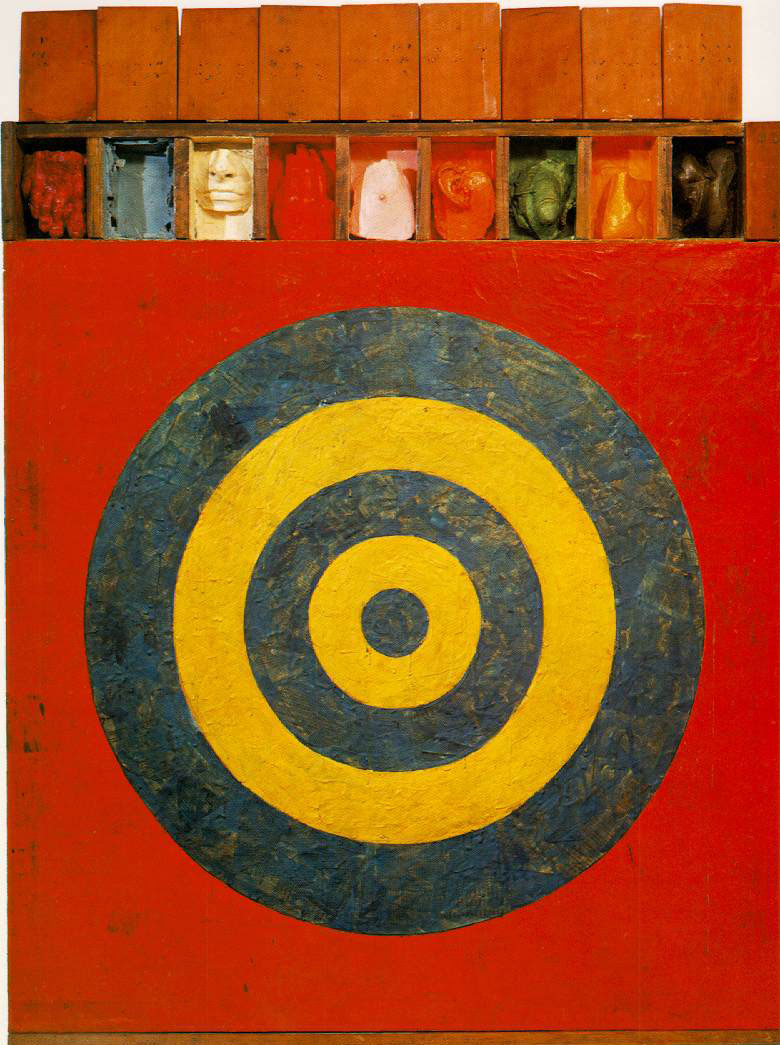what kind of symmetry best describes jasper johns’ 1955, target with four faces?
The target also focuses attention on the theme of viewing. the contrasting circles of the target are meant to aid distant vision; the target is something to see clearly, to aim at. This makes the target a true visual display – it has no other purpose, no other reason for existence.
The image of the target emerges in Johns work in 1955, in paintings that incorporate frieze like arrangements of plaster casts taken from parts of the body. Target with Four Faces is one of the serie paintings and drawings of the target image from 1958 to 1961. Each of these Target paintings by Johns features a depiction of an actual target that is, for all practical purposes, utterly interchangeable with the real thing. Yet unlike the flag or the number, which are also familiar images from this period of the artist’s career, the flat target is simultaneously representational and abstract (a number or a flag can never be divorced from its status as a familiar sign). This makes the target susceptible to other ambiguities. Targets imply, or are instruments of, seeing across space (and seeing as an act of potential violence). But the optical nature of the concentric bands can also be understood to figure distraction rather than focus, something that is also suggested by the mechanical action of a rotating compass by which the image of a target is produced.
You’ll immediately recognize its subject: the alternating bands of color, the concentric circles, even a bull’s eye. In fact, Johns described the Target as something that “the mind already knows.”
Cara Manes: This is Jasper Johns’s Target With Four Faces from 1955.

In the mid-1950s Johns incorporated symbols such as numbers, flags, maps, and targets into his paintings. Here, he transforms the familiar image of a target into a tangible object by building up the surface with wax encaustic. As a result, the concentric circles have become less precise and more tactile. Above the target Johns has added four cropped and eyeless faces, plaster casts taken from a single model over a period of several months. Their sculptural presence reinforces the objectness of the painting, particularly as the faces may be shut away in their niches behind a hinged wooden door.
In 2018–19, MoMA collaborated with Google Arts & Culture Lab on a project using machine learning to identify artworks in installation photos. That project has concluded, and works are now being identified by MoMA staff.

“There may also be a deeply personal meaning to these works, which relates to Johns identity as a closeted gay man from the American South living in the persecutory, anti-communist and homophobic era of Senator Joseph McCarthy” she writes. “Intimately involved with Robert Rauschenberg in the second half of the 1950s, Johns, who let the phrase ‘History and Biography’ show through a layer of encaustic in the upper right-hand panel of Target with Four Faces, may have felt himself a target of considerable hostility.
Provocative? Well, yes. Today, those concentric circles are a familiar visual motif, yet when Johns was painting them, the target was more commonly confined to military or firearms settings – which may account for Johns’ preoccupation with the target. Yet Johns’ targets also examine how we observe and are, in turn, observed.

Here Johns combined several of the motifs and symbols from his earlier paintings in a constrained palette of gray, black, and white. The upper right-hand corner of the painting contains half of a device circle. In 1959, Johns adopted a technique in which he attached a wooden slat, usually a ruler or canvas stretcher, to the painting to create a compass-drawn circle. The device dragged through the paint formed a target that echoed his earlier target paintings. However, here he interrupted the concentric circles of the target with an imprint of his outstretched hand. The handprint suggests the replacement of the artist’s hand with a mechanical device.
Encaustic on newspaper and cloth over canvas surmounted by four tinted-plaster faces in wood box with hinged front – The Museum of Modern Art, New York
Resources:
http://www.moma.org/audio/playlist/1/546
http://www.moma.org/collection/works/78393
http://www.phaidon.com/agenda/art/articles/2017/may/15/what-was-the-target-in-jasper-johns-paintings/
http://m.theartstory.org/artist/johns-jasper/artworks/
http://www.jasper-johns.org/target-with-four-faces.jsp
